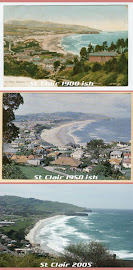copied from stuff.co.nz
Six of the country's best surf breaks are just a short ride away from getting national park status. By PHIL HAMILTON - The Press | Friday, 26 September 2008
Under the Department of Conservation's proposed coastal policy, the six surf breaks of national significance Shipwrecks in Ahipara, Raglan, Stent Road in Taranaki, White Rock in the Wairarapa, Mangamaunu near Kaikoura and Papatowai in the Catlins would become protected surfing reserves.
However, the Christchurch City Council has opposed the move at hearings this week despite none of the breaks falling within its boundaries.
 (pic: CORY SCOTT/The Press - NOT EXPENDABLE: Daniel Kereopa, of Raglan, drops into a giant wave at Papatowai in the Catlins, one of six breaks that could get national park status.)
(pic: CORY SCOTT/The Press - NOT EXPENDABLE: Daniel Kereopa, of Raglan, drops into a giant wave at Papatowai in the Catlins, one of six breaks that could get national park status.)Christchurch surfer and lawyer Jonathan McCarthy, who will speak at the hearings today on behalf of Surfing NZ and Surfers Environmental Advocacy, said it was essential the breaks were protected as other surf spots had been considered expendable in the past by local and central government.
He cited the Whangamata marina controversy and a famous wave in Mundaca, Spain that disappeared after dredging to deepen a harbour destroyed the sand bars.
"Literally overnight they destroyed one of the world's greatest waves," he said.
"That is the equivalent of climbers no longer being able to climb Aoraki or Everest."
He said surfing reserves were the only way of ensuring waves were protected, with both access by surfers and the swell guaranteed. It would prevent such activities as high density mussel farms or sand dredging that could ruin a wave or block the swell getting in.
McCarthy said New Zealand trailed Australia which had already established surfing reserves in New South Wales and Victoria.
Long-time Christchurch surfer, photographer and teacher Warren Hawke said it was an idea whose time had come.
"It's timely it happens now because of of the growth of things like mussel farming," he said.
"It's really important recreational users of the sea, their use is protected in the future.
"As they say, we are caretakers for our children."
The 55-year-old, who is the principal of Governors Bay School, first surfed Mangamaunu in 1969 and said it deserved to be included among the nation's six best spots.
"It's the classic Rincon-style (in California) point break, it's very well known, people can see it from the main road and tourists often stop there to watch the surfers."
Hawke said he would like to see Banks Peninsula's Hickory and Magnet bays also made surfing reserves.
Christchurch council healthy environment programme manager Jenny Ridgen said the council was not opposed to surf breaks but to the principle and approach of protecting one particular leisure activity.
"This is just one of many issues along with diving spots and fishing spots," she said.
"But it seems to have been given specific preference and our concern is it sets it above other things that are equally important to others."
Ridgen said the council believed the protection of nationally significant surf spots would come under another policy that covered the maintenance and enhancement of natural sites of particular value for outdoor recreation.
"We don't think it's good policy."
The hearings will conclude in mid-December and recommendations for the coastal policy will then be sent to the Minister of Conservation.








